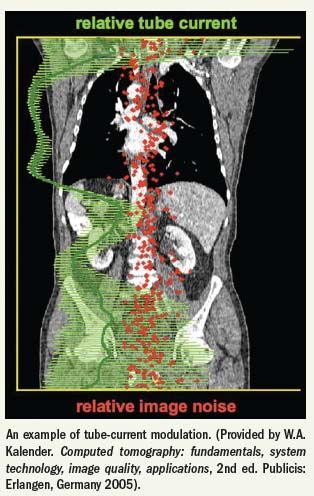- AI
- Molecular Imaging
- CT
- X-Ray
- Ultrasound
- MRI
- Facility Management
- Mammography
Outdated CT protocols called widespread in imaging units
The scanner could be brand new, but there is a good chance it’s operating with old protocols imported from a previous unit and not optimized for best imaging at the reduced dose levels possible today, a researcher suggests.
The scanner could be brand new, but there is a good chance it’s operating with old protocols imported from a previous unit and not optimized for best imaging at the reduced dose levels possible today, a researcher suggests.
Outdated CT protocols are a widespread problem, according to Dr. Aaron Sodickson, assistant director of emergency radiology at Brigham and Women’s Hospital in Boston, Massachusetts.
“Many practices don’t take full advantage of available dose-reduction tools,” he said in an interview about his presentation at the American Roentgen Ray Society meeting. “There have been great advances in CT technology that enable reduction in radiation exposure while still getting high-quality images. But because of all these advances, people have a hard time keeping up.”

Each practice needs a local champion responsible for protocol oversight and optimization, but they can only do that with the right information, he said.
“They need information from the manufacturer about what the available tools are and how to make the best use of them,” he said.
CT protocols are often ported from older scanners to newer scanners essentially unchanged, which may result in unnecessary radiation exposure for patients. Optimal scan acquisition is the radiologist’s responsibility, and there are several steps radiologists can take to dose-optimize their CT protocols, Sodickson said in his presentation.
General strategies radiologists can implement include:
• Use size-dependent protocols;
• Understand and enable dose-reduction tools;
• Reduce the number of passes through a body region;
• Reduce duplicate or overlapping coverage;
• Reduce mAs for high-contrast imaging;
• Optimize IV contrast infusion timing; and
• Lower kVp if patient size allows.
The most important of these is size-dependent protocols, Sodickson said. Good-quality images can be obtained with many fewer x-rays in small patients than in large patients, so scan techniques must be adapted to patient size. Most modern scanners include robust tube current modulation methods to adjust the x-ray output according to patient size, but the tools must be enabled and properly used. These tools not only adjust to overall size differences, but can also account for variations during the course of the scan. Certain body regions, like the chest, contain less tissue to attenuate x-rays, which allows a reduction in x-ray tube output while still maintaining good diagnostic-quality images.
An exciting area for dose reduction imaging is lower kVp, which uses lower energy x-rays, Sodickson said. By reducing kVp, radiologists can get high-quality images with a lot less radiation exposure, particularly when used for vascular imaging with iodinated contrast. However, these techniques work only for smaller patients who do not attenuate all of the lower energy x-rays.
“All of these general strategies are fairly well-known, but they need to be more universally adopted in day-to-day practice,” he said.
Sites need to spend some time updating and improving their protocols, he said. Specific protocol details need to take into account the technology available on each scanner, which can pose challenges for practices with multiple models and manufacturers.
Another frequent problem is a void in who decides how the protocols will be set. Most radiologists primarily think of themselves as image interpreters and most technologists follow the radiologists’ lead, with no one taking full responsibility for setting protocols.
“Protocol optimization ideally requires a strong collaborative effort between CT manufacturers, radiologists, technologists, and medical physicists,” Sodickson said.
Can CT-Based AI Provide Automated Detection of Colorectal Cancer?
February 14th 2025For the assessment of contrast-enhanced abdominopelvic CT exams, an artificial intelligence model demonstrated equivalent or better sensitivity than radiologist readers, and greater than 90 percent specificity for the diagnosis of colorectal cancer.
Key Chest CT Parameters for Body Composition May be Prognostic for Patients with Resectable NSCLC
February 11th 2025A high intermuscular adipose index has a 49 percent increased likelihood of being associated with lower overall survival in patients with resectable non-small cell lung cancer (NSCLC), according to new research.
The Reading Room: Racial and Ethnic Minorities, Cancer Screenings, and COVID-19
November 3rd 2020In this podcast episode, Dr. Shalom Kalnicki, from Montefiore and Albert Einstein College of Medicine, discusses the disparities minority patients face with cancer screenings and what can be done to increase access during the pandemic.
Comparative AI Study Shows Merits of RapidAI LVO Software in Stroke Detection
February 6th 2025The Rapid LVO AI software detected 33 percent more cases of large vessel occlusion (LVO) on computed tomography angiography (CTA) than Viz LVO AI software, according to a new comparative study presented at the International Stroke Conference (ISC).
New CT Angiography Study Shows Impact of COVID-19 on Coronary Inflammation and Plaque
February 5th 2025Prior COVID-19 infection was associated with a 28 percent higher progression of total percent atheroma volume (PAV) annually and over a 5 percent higher incidence of high-risk plaque in patients with coronary artery lesions, according to CCTA findings from a new study.
